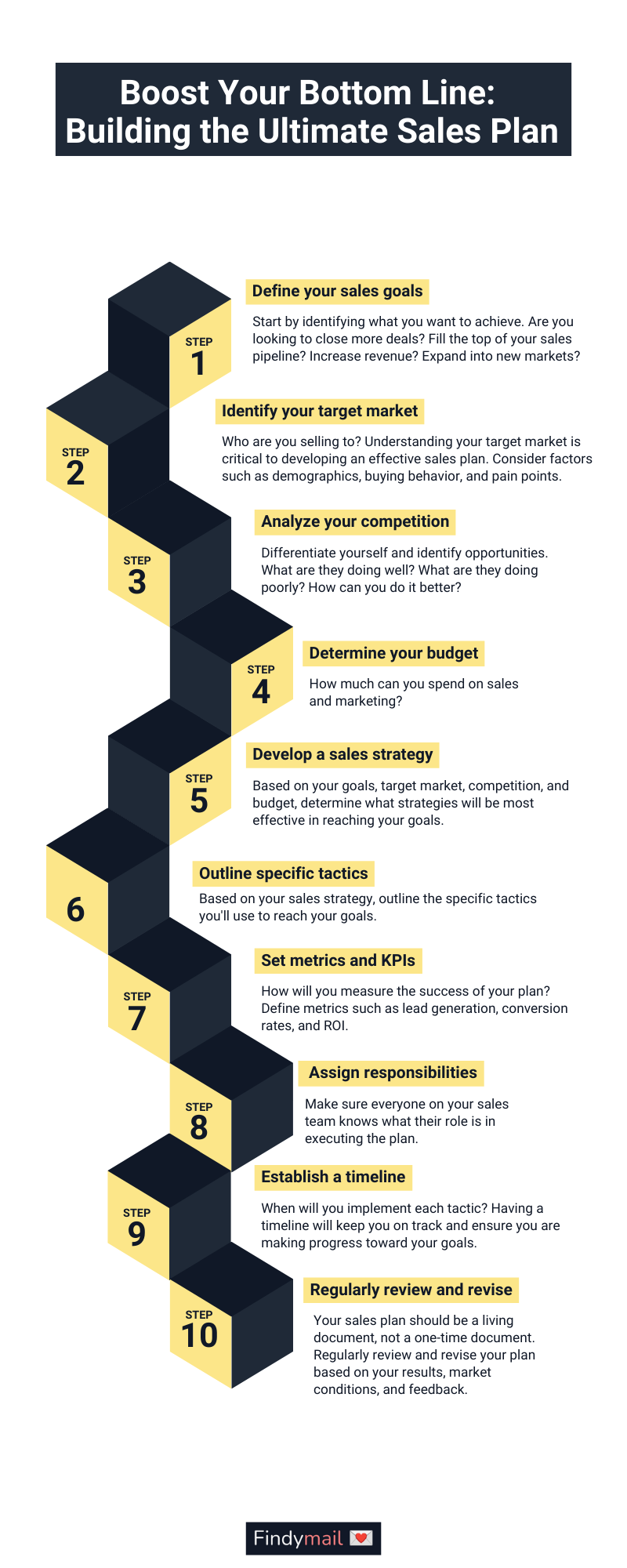As a B2B sales professional or manager, trying to consistently hit your targets and close more deals can get overwhelming. You pour hours into reaching out to potential clients, but sometimes it seems like no matter what you do, the results just aren't there.
If this sounds familiar, don't worry– you're not alone! The sales game can be rough, but the good news is, it's far from impossible.
As someone who's seen it all when it comes to cold emails, I can tell you that having a solid sales plan is the key to success. A well-thought-out plan helps you prioritize your efforts and gives you a roadmap to follow when things get tough.
Think of it like having a trusty GPS guiding you through the sales jungle.
Unfortunately, it can be challenging to find sales plans that aren’t confusing and convoluted. So in this article, I’ll give you actionable tips for creating a sales plan and provide examples so you can build one that delivers results ASAP.
So sit back, grab a coffee (or a stiff drink, I won't judge), and let's start hacking our way through sales together!
What’s a Sales Plan?
First, let’s all get on the same page.
A sales plan is a document that outlines the strategies and tactics you'll use to reach your sales goals. It’s sort of a blueprint for your sales success. It's not enough to just know what you want to achieve; you need a plan to make it happen.
And it’s not a one-and-done– your sales plan should be a living document that you constantly revise and update as you learn more about your market and customers. Your plan should evolve with you, adjusting to the changing landscape of your industry, the needs of your target market, and newfound sales knowledge.
So why bother with a sales plan? Simply put, having a sales plan helps you stay focused and motivated. It gives you a clear direction to follow and helps you track your progress along the way.
With one in place, you'll be able to make informed decisions, allocate your resources to effective tactics instead of wasting time, and ultimately generate more revenue.
The 3 Main Parts of a Good Sales Plan
A sales plan is like a three-legged stool; if one leg is weak, the whole thing falls apart. You need to think about three pillars when creating your plan: strategy, processes, and tools.
Let's take a closer look:
● Strategy: This is the heart of the plan and should be based on all the research you've done on your target market, competition, and budget. Think of your strategy as a roadmap to success– but instead of telling you how to get from point A to point B, it tells you how to get from "I got a lead" to "I got a sale."
● Processes: A good sales process is like a recipe, but instead of making a cake, you're making a sale. It's a step-by-step guide to help your sales team cook up some tasty deals. Having well-defined processes will ensure that your sales team uses the same recipe, so your sales are consistent and efficient.
● Tools: Using tools can help you automate and streamline your sales processes, freeing up your team to focus on the important stuff like closing deals and making you money. Just like when you're cooking, having the right tools makes everything more enjoyable, and you're less likely to burn the house down (or, in this case, your revenue).
Focusing on these 3 vital components, you’ll have a solid foundation for building an effective sales plan. And that's a good thing, because nobody wants a wobbly stool, especially when it's loaded with money-making opportunities!
How Do I Create a Sales Plan?
OK, it’s clear that a sales plan is a secret weapon in your arsenal, but how do you actually write one?

Don't worry; it's not rocket science. Follow these simple steps to get started:
1. Define your sales goals: Start by identifying what you want to achieve. Are you looking to close more deals? Fill the top of your sales pipeline? Increase revenue? Expand into new markets? Whatever your goals may be, make sure they are SMART: specific, measurable, and achievable.
2. Identify your target market: Who are you selling to? Understanding your target market is critical to developing an effective sales plan. Consider factors such as demographics, buying behavior, and pain points.
3. Analyze your competition: Understanding your competitors will help you differentiate yourself and identify opportunities. What are they doing well? What are they doing poorly? How can you do it better?
4. Determine your budget: How much do you have to spend on sales and marketing? Your budget will help determine what tactics you can afford to implement.
5. Develop a sales strategy: Based on your goals, target market, competition, and budget, determine what strategies will be most effective in reaching your goals. Will you focus on lead generation or account-based sales? Will you invest in digital marketing or events?
6. Outline specific tactics: Based on your sales strategy, outline the specific tactics you'll use to reach your goals. This might include cold email campaigns, sales enablement tools, or product demos. Make sure these tactics are aligned with your sales strategy and budget.
7. Set metrics and KPIs: How will you measure the success of your plan? Define metrics such as lead generation, conversion rates, and ROI. This will help you track your progress and adjust your plan as needed.
8. Assign responsibilities: Make sure everyone on your sales team knows what their role is in executing the plan. Having clear responsibilities and accountability will help everything run smoothly. Don’t forget about motivating your team, either.
9. Establish a timeline: When will you implement each tactic? Having a timeline will keep you on track and ensure you are making progress toward your goals.
10. Regularly review and revise: Your sales plan should be a living document, not a one-time document. Regularly review and revise your plan based on your results, market conditions, and feedback from your team.
Writing a sales plan may seem daunting, but by following these simple steps, you'll be well on your way to boosting your bottom line and closing more deals.
3 Examples of Sales Plans
A General Sales Plan
Here’s a great example I found on Reddit that lays out what a general sales plan will look like (I’ve made a few edits for clarity):
1. Purpose: who it's for and what it is
2. Branding, Value Proposition: what you do for companies
3. Branding, Brand Promise: what you do for your customers
4. Product Brief: 1 paragraph descriptions of each product
5. Product Detail: product-specific value propositions, features, how it aligns with [the] brand’s value proposition, the one most important buyer persona, and talking points for sales discovery calls
6. Buyer personas: 1 slide for each persona, bullet points for their goals, challenges, objections, purchase triggers, and your positioning for that persona
7. Style guide: how you look and how you talk
8. Social campaigns: what you're going to do on social media
9. Content marketing strategies: a concise 1-slide plan of the amount and kind of content
10. Paid media strategies: a concise 1-slide plan of keywords/sites/ABM points
11. Sales & marketing library: links to all supporting documents
They call this “Total Brand Awareness for Sales & Marketing,” and I’ve used it myself when first starting out. It’s great when you’re overwhelmed with information (hello, startups), and you want to start systematizing things in a way that gets you to more revenue faster.
The 30-60-90-Day Sales Plan
This plan is one of the top choices for marketers because it breaks down your sales goals into three manageable chunks, each covering a period of 30, 60, and 90 days.
This type of plan is perfect for new sales hires because it helps them get up to speed quickly and feel confident in their role. And for your existing team, it gives them a clear understanding of what you expect from them; no more guessing games.
Here’s what a 30-60-90-Day plan looks like:
Phase 1 (Days 1-30)
● Get familiar with the company's products, services, and processes.
● Meet with key stakeholders, including sales managers, product managers, and customer service representatives.
● Start building a list of target customers and prioritize them based on potential revenue and urgency.
● Research your target customers to learn about their pain points, decision-making process, and budget.
● Start reaching out to potential customers, either through cold calls, emails, or LinkedIn messages.
● Set up meetings with potential customers to discuss their needs and how your company can help.
● Start tracking your progress and make any necessary adjustments to your sales strategy.
Phase 2 (31-60)
● Start building relationships with key customers and establish trust with them.
● Follow up with customers you've met within the first 30 days to gauge their level of interest.
● Begin creating customized proposals and presentations for each customer based on their specific needs.
● Prepare for and participate in negotiations with customers to close deals.
● Collaborate with your team and other departments (e.g., marketing, customer service) to ensure a seamless customer experience.
● Continuously gather feedback from customers and make improvements to your sales process.
● Start tracking your progress towards your sales targets and make any necessary adjustments.
Phase 3 (61-90)
● Maintain ongoing relationships with key customers and continue to provide excellent customer service.
● Seek out opportunities for upselling and cross-selling to existing customers, as well as gathering sales referrals.
● Refine your sales process based on what you've learned in the first 60 days.
● Work with your team to identify new target customers and repeat the sales process with them.
● Provide regular updates to your sales manager and other stakeholders on your progress and any challenges you're facing.
● Continuously gather feedback from customers and make improvements to your sales process.
● Celebrate your successes and acknowledge areas for improvement to continue growing as a sales professional.
The Marketing-Aligned Sales Plan
We all know that sales and marketing can sometimes be like oil and water, but what if I told you that they could actually be the best of friends?
Enter the Marketing-Aligned Sales Plan.
This type of sales plan is all about getting your sales and marketing teams on the same page and working towards the same goal.
Think about it: if your sales team is armed with the latest and greatest marketing materials, they'll have all the ammo they need to close deals like a boss.
And, if your marketing team knows exactly what kind of leads your sales team is looking for, they can tailor their efforts to deliver the right kind of leads right to your sales team's doorstep. It's a win-win!
Here’s a template you can follow for a Marketing-Aligned plan:
1. Introduction
● Brief overview of the plan's purpose and goals
2. Goals & Objectives
● Specific goals and objectives aligned with company strategy
3. Target Audience
● Demographic and psychographic info
4. Market Segmentation
● Breakdown of the target audience into smaller segments
5. Marketing Mix
● Tools and tactics for reaching target audience (product, price, place, promotion)
6. Sales Process
● Step-by-step sales process (lead gen, qualifying, presenting, closing, follow-up)
7. Sales Team
● Roles and responsibilities (sales manager, reps, support)
8. Sales Metrics
● Metrics for measuring success (lead gen, conversion rate, sales value, customer satisfaction, etc.)
9. Budget
● Budget for marketing, sales team, technology
10. Timeline
● Specific milestones and deadlines
11. Evaluation & Adjustments
● Plan for regular evaluation and adjustments
With these 3 examples, you’ll have a sound basis for what goes into making a winning sales plan!
Final Thoughts
Well, that about does it!
You've now got a solid understanding of what a sales plan is, why it's essential, and how to get started. Whether you're starting from scratch or revamping your current strategy, taking the time to create a solid plan can make all the difference.
And don't forget; these are just examples– the beauty of sales planning is that it can be tailored to fit your unique needs and goals. So don’t be afraid to experiment and rework them until it’s just what you need.
Just remember this key piece of info– a little bit of planning can go a long way in boosting your bottom line and taking your sales game to the next level. Good luck, and happy selling!






